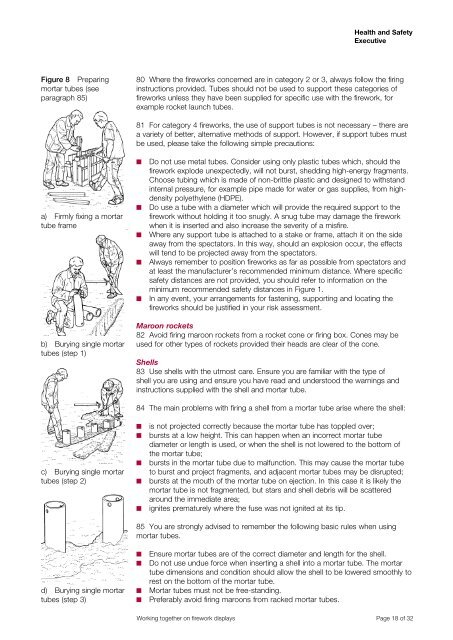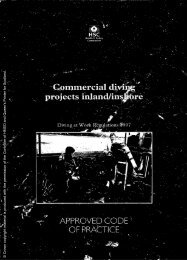HSG123: Working together on firework displays - Health and Safety ...
HSG123: Working together on firework displays - Health and Safety ...
HSG123: Working together on firework displays - Health and Safety ...
You also want an ePaper? Increase the reach of your titles
YUMPU automatically turns print PDFs into web optimized ePapers that Google loves.
Figure 8 Preparing<br />
mortar tubes (see<br />
paragraph 85)<br />
a) Firmly fixing a mortar<br />
tube frame<br />
b) Burying single mortar<br />
tubes (step 1)<br />
c) Burying single mortar<br />
tubes (step 2)<br />
d) Burying single mortar<br />
tubes (step 3)<br />
<strong>Health</strong> <strong>and</strong> <strong>Safety</strong><br />
Executive<br />
80 Where the <strong>firework</strong>s c<strong>on</strong>cerned are in category 2 or 3, always follow the firing<br />
instructi<strong>on</strong>s provided. Tubes should not be used to support these categories of<br />
<strong>firework</strong>s unless they have been supplied for specific use with the <strong>firework</strong>, for<br />
example rocket launch tubes.<br />
81 For category 4 <strong>firework</strong>s, the use of support tubes is not necessary – there are<br />
a variety of better, alternative methods of support. However, if support tubes must<br />
be used, please take the following simple precauti<strong>on</strong>s:<br />
n Do not use metal tubes. C<strong>on</strong>sider using <strong>on</strong>ly plastic tubes which, should the<br />
<strong>firework</strong> explode unexpectedly, will not burst, shedding high-energy fragments.<br />
Choose tubing which is made of n<strong>on</strong>-brittle plastic <strong>and</strong> designed to withst<strong>and</strong><br />
internal pressure, for example pipe made for water or gas supplies, from highdensity<br />
polyethylene (HDPE).<br />
n Do use a tube with a diameter which will provide the required support to the<br />
<strong>firework</strong> without holding it too snugly. A snug tube may damage the <strong>firework</strong><br />
when it is inserted <strong>and</strong> also increase the severity of a misfire.<br />
n Where any support tube is attached to a stake or frame, attach it <strong>on</strong> the side<br />
away from the spectators. In this way, should an explosi<strong>on</strong> occur, the effects<br />
will tend to be projected away from the spectators.<br />
n Always remember to positi<strong>on</strong> <strong>firework</strong>s as far as possible from spectators <strong>and</strong><br />
at least the manufacturer’s recommended minimum distance. Where specific<br />
safety distances are not provided, you should refer to informati<strong>on</strong> <strong>on</strong> the<br />
minimum recommended safety distances in Figure 1.<br />
n In any event, your arrangements for fastening, supporting <strong>and</strong> locating the<br />
<strong>firework</strong>s should be justified in your risk assessment.<br />
Maro<strong>on</strong> rockets<br />
82 Avoid firing maro<strong>on</strong> rockets from a rocket c<strong>on</strong>e or firing box. C<strong>on</strong>es may be<br />
used for other types of rockets provided their heads are clear of the c<strong>on</strong>e.<br />
Shells<br />
83 Use shells with the utmost care. Ensure you are familiar with the type of<br />
shell you are using <strong>and</strong> ensure you have read <strong>and</strong> understood the warnings <strong>and</strong><br />
instructi<strong>on</strong>s supplied with the shell <strong>and</strong> mortar tube.<br />
84 The main problems with firing a shell from a mortar tube arise where the shell:<br />
n is not projected correctly because the mortar tube has toppled over;<br />
n bursts at a low height. This can happen when an incorrect mortar tube<br />
diameter or length is used, or when the shell is not lowered to the bottom of<br />
the mortar tube;<br />
n bursts in the mortar tube due to malfuncti<strong>on</strong>. This may cause the mortar tube<br />
to burst <strong>and</strong> project fragments, <strong>and</strong> adjacent mortar tubes may be disrupted;<br />
n bursts at the mouth of the mortar tube <strong>on</strong> ejecti<strong>on</strong>. In this case it is likely the<br />
mortar tube is not fragmented, but stars <strong>and</strong> shell debris will be scattered<br />
around the immediate area;<br />
n ignites prematurely where the fuse was not ignited at its tip.<br />
85 You are str<strong>on</strong>gly advised to remember the following basic rules when using<br />
mortar tubes.<br />
n Ensure mortar tubes are of the correct diameter <strong>and</strong> length for the shell.<br />
n Do not use undue force when inserting a shell into a mortar tube. The mortar<br />
tube dimensi<strong>on</strong>s <strong>and</strong> c<strong>on</strong>diti<strong>on</strong> should allow the shell to be lowered smoothly to<br />
rest <strong>on</strong> the bottom of the mortar tube.<br />
n Mortar tubes must not be free-st<strong>and</strong>ing.<br />
n Preferably avoid firing maro<strong>on</strong>s from racked mortar tubes.<br />
<str<strong>on</strong>g>Working</str<strong>on</strong>g> <str<strong>on</strong>g>together</str<strong>on</strong>g> <strong>on</strong> <strong>firework</strong> <strong>displays</strong> Page 18 of 32







